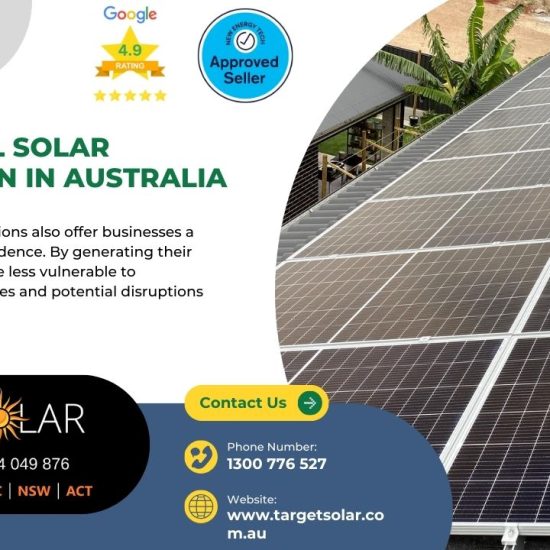Have you ever wondered how to reduce energy costs in healthcare facilities? Then, you’ve come to the right place. In the ever-evolving world of healthcare, managing operational costs is a constant challenge, and energy expenses play a significant role in this equation. But what if there was a sustainable and cost-effective solution?
In this blog, we’re going to share valuable insights into how solar energy can not only significantly cut down energy costs but also enhance the overall efficiency of healthcare facilities. We’ll dive into the benefits of solar power, explore the various solar solutions available, and provide a comprehensive guide on how to get started with solar energy, from initial consultation to installation.
At Target Solar, we are committed to providing top-notch solar solutions tailored specifically for healthcare facilities. With years of experience and expertise in the field of renewable energy, we understand the unique needs and challenges of healthcare settings. Our goal is to help you harness the power of the sun to not only reduce costs but also to contribute to a healthier, more sustainable environment.
Section 1: The Rising Challenge of Energy Costs in Healthcare
In today’s healthcare landscape, one of the most pressing concerns is the escalating energy expenses. Managing a healthcare facility involves a delicate balance between providing top-notch care and maintaining operational efficiency. Energy costs, often a significant portion of a facility’s operating budget, have been steadily rising, adding to this challenge.
Why is this happening? The reasons are manifold. Healthcare facilities operate round the clock, powering essential life-saving equipment, maintaining critical temperature-controlled environments, and ensuring well-lit, welcoming spaces for patients and staff. This constant energy use makes them one of the most energy-intensive buildings, with energy bills reflecting this high usage.
The impact of these soaring energy costs is far-reaching. It’s not just about the bottom line; it affects every aspect of healthcare delivery. When a substantial part of the budget is allocated to energy bills, there’s less available for patient care, staff training, and facility upgrades. In some cases, it can even lead to cutbacks in services or staff, which no healthcare provider ever wants to face.
Let me share a personal anecdote that underscores this issue. A few years ago, I visited a small community hospital grappling with budget constraints due to high energy costs. The hospital faced a tough decision: either reduce energy consumption or cut back on patient services. It was a stark reminder of how energy expenses can directly impact patient care and the ability to provide essential health services.
This real-life example is not unique. Many healthcare facilities are facing similar dilemmas, making it clear that finding ways to reduce energy costs is not just a financial imperative but a crucial aspect of sustaining quality healthcare delivery.
Section 2: Unveiling the Power of Solar Energy
As we navigate the complexities of energy costs in healthcare, there emerges a beacon of hope: solar energy. Solar power, a clean and renewable source of energy, is increasingly becoming a game-changer for healthcare facilities worldwide. But what exactly is solar energy, and how does it fit into the healthcare energy puzzle?
Simply put, solar energy involves harnessing the sun’s power using photovoltaic (PV) panels. These panels convert sunlight into electricity, which can then be used to power a healthcare facility. This process is not only eco-friendly, but it also reduces dependence on traditional, often more expensive, energy sources.
Now, let’s delve into the tangible benefits of solar energy for healthcare facilities. The most immediate and impactful benefit is cost savings. By generating their own electricity, healthcare facilities can significantly reduce their energy bills. Over time, the savings accumulated can be redirected towards enhancing patient care, upgrading equipment, or even expanding services.
But the benefits of solar energy extend far beyond cost savings. It’s a sustainable choice, reducing the carbon footprint of healthcare facilities. In a world increasingly conscious of environmental impact, adopting solar energy reflects a commitment to sustainability and responsible energy use.
Moreover, solar energy is remarkably reliable. Once installed, solar panels require minimal maintenance and can provide a consistent energy supply for years. This reliability is crucial in healthcare settings, where consistent power is essential for patient safety and care.
Let’s not forget the success stories. Numerous healthcare facilities have made the switch to solar and reaped its benefits. For instance, a regional hospital in [Location] recently transitioned to solar power, resulting in a 40% reduction in their energy costs within the first year. Another example is a clinic in [Another Location] that now runs entirely on solar energy, ensuring uninterrupted power supply even in times of grid instability.
These stories are more than just numbers; they represent a growing trend towards a more sustainable and financially sound approach to healthcare facility management. With each solar panel installed, we move a step closer to a future where quality healthcare and environmental stewardship go hand in hand.
Section 3: In-Depth Exploration of Solar Solutions
In our quest to mitigate energy costs in healthcare, it’s crucial to understand the various solar solutions at our disposal. The beauty of solar energy lies in its versatility and adaptability to different needs and environments. In this section, we’ll explore the diverse range of solar solutions suitable for healthcare facilities and how they can be customized to meet specific requirements.
First, let’s discuss the primary types of solar solutions available:
- Rooftop Solar Panels: Ideal for facilities with ample roof space, rooftop solar panels are a common and effective way to harness solar energy. They are particularly beneficial in urban settings where ground space might be limited.
- Ground-Mounted Solar Systems: For healthcare facilities with available land, ground-mounted systems offer an excellent way to utilize open space for energy generation. These systems can be scaled up depending on the facility’s energy needs and available land.
- Solar Carports: An innovative solution that serves a dual purpose – providing shade for parking while generating electricity. Solar carports are an excellent option for facilities looking to maximize their existing space without significant structural changes.
- Solar Battery Storage Systems: These systems store excess solar energy, ensuring a consistent power supply even when the sun isn’t shining. This is particularly crucial for healthcare facilities that require a reliable energy source at all times.
Each of these solutions can be tailored to meet the unique energy needs of a healthcare facility. Customization might involve adjusting the size of the installation, integrating it with existing power systems, or even incorporating smart technology for enhanced energy management.
Speaking of advancements, the solar energy sector is continuously evolving with new technologies and trends. Some of the latest developments include high-efficiency solar panels, which offer greater power output from smaller surfaces, and smart solar systems that can be monitored and managed remotely, ensuring optimal performance and efficiency.
Another exciting trend is the integration of solar energy with other renewable technologies, such as wind power or geothermal energy, to create hybrid systems. These systems can provide a more comprehensive energy solution, further reducing reliance on traditional power sources.
The key takeaway here is that solar solutions are not one-size-fits-all. They are diverse, scalable, and customizable, making them suitable for a wide range of healthcare facilities, from small clinics to large hospitals. By staying abreast of the latest trends and technologies, healthcare facilities can not only reduce their energy costs but also position themselves at the forefront of sustainability and innovation.
Section 4: Getting Started with Solar – A Step-by-Step Guide
Embarking on your solar energy journey is easier than you might think. At Target Solar, we’ve streamlined the process into quick, manageable steps, ensuring a smooth and hassle-free transition to solar power. Here’s how you can get started with our No Cost Solar program for healthcare Facility:
Step 1: Contact Us
- Reach out to begin your solar journey. Our team is ready to guide you through every step, ensuring a personalized and informed experience.
Step 2: Understanding No Cost Solar Terms and PPA
- We’ll explain the no upfront cost terms and Power Purchase Agreement (PPA) details, ensuring you have a clear understanding of the process and the financial benefits.
Step 3: Identifying Your Requirements
- Our conversation will focus on your specific energy needs and goals, allowing us to tailor our services to perfectly fit your facility.
Step 4: Site Assessment
- Our experts conduct a thorough evaluation of your premises. This step is crucial to ensure optimal placement and performance of the solar panels.
Step 5: Energy Requirement Analysis
- We analyze your current energy usage to create a solar solution that meets your specific demands, ensuring maximum efficiency and cost-effectiveness.
Step 6: Customized Quotation
- You’ll receive a detailed quote tailored to your energy needs and site specifications, providing complete transparency and clarity.
Step 7: Q&A Sessions
- Our comprehensive question and answer sessions are designed to address any queries or concerns you may have, ensuring you’re fully informed.
Step 8: Agreement Sign-Up
- Once you’re comfortable and ready, you can sign the agreement, which officially kickstarts your solar project.
Step 9: Installation Process
- Our certified professionals will efficiently install your solar system with minimal disruption, following our meticulous solar project management process.
Step 10: System Setup and Testing
- After installation, we conduct rigorous testing to ensure the system functions optimally and meets our high standards.
Step 11: Hand Over and Dedicated Support
- Post-installation, we provide you with all necessary information and continue to offer dedicated support for any future needs or questions.
Step 12: After-Services
- Benefit from our ongoing maintenance and support services, which are key to ensuring the longevity and efficiency of your solar system.
Step 13: Enjoy Solar Energy at Fixed Rates
- Start using solar energy at predictable, fixed rates, giving you protection from fluctuating energy costs and budget certainty.
Step 14: Save Money
- Witness a significant reduction in your energy bills while contributing to a more sustainable future.
GET YOUR QUOTE NOW – Reduce Energy Costs in Healthcare Facility
- Don’t wait any longer to start saving. Contact us today to get your personalized solar solution quote and join the growing number of healthcare facilities harnessing the power of the sun.
Section 5: Post-Installation – Maximizing Benefits and ROI
After the successful installation of your solar system, the journey towards energy efficiency and cost savings is just beginning. In this final section, we’ll delve into the crucial aspects of maintenance, monitoring, and integration of your solar system to ensure you maximize its benefits and ROI (Return on Investment).
Maintenance and Monitoring of Solar Systems
- The key to maintaining the efficiency of your solar panels lies in regular maintenance and monitoring. Fortunately, solar systems require minimal upkeep. Routine checks and cleaning to remove any debris or dirt accumulation will suffice.
- Modern solar systems come equipped with advanced monitoring technology. This allows you to track the performance of your panels in real-time, ensuring they operate at peak efficiency. Any issues can be promptly identified and addressed, minimizing downtime.
Tracking Energy Savings and ROI
- One of the most gratifying aspects of switching to solar is witnessing the reduction in energy costs. To track these savings effectively, we provide a detailed comparison of your pre- and post-solar energy bills.
- Understanding your ROI is crucial. We help you calculate the payback period of your investment by considering factors like energy savings, tax incentives, and the increased value of your property due to the solar installation.
- Our team offers ongoing support in analyzing your energy consumption patterns, helping you optimize energy usage for further savings.
Integrating Solar Power with Existing Energy Systems
- For many healthcare facilities, solar power is part of a broader energy strategy. Integrating solar power with your existing energy systems is essential for optimal performance.
- We guide you through the process of integration, which may involve configuring solar power as a primary source while keeping the grid connection as a backup, or vice versa.
- Additionally, we explore opportunities for using excess solar energy. For instance, stored solar energy can be used during peak hours when grid electricity rates are higher, leading to increased cost savings.
Optimizing Solar Performance
- Beyond installation, we work with you to continually optimize the performance of your solar system. This may involve adjusting the tilt of the panels seasonally or implementing energy-saving measures within your facility.
- Our team remains at your disposal for advice, updates on new solar technologies, and any adjustments that may be required as your facility’s energy needs evolve.
By following these guidelines, healthcare facilities can not only enjoy reduced energy costs but also play a pivotal role in promoting sustainable practices. The transition to solar energy, backed by proper maintenance, monitoring, and integration, is a step towards a greener and more cost-effective future in healthcare.
Conclusion:
As we wrap up our exploration into reducing energy costs in healthcare facilities through solar power, let’s revisit the key insights shared in this blog. We started by discussing the rising challenge of energy costs in healthcare and the pressing need for sustainable solutions. We then unveiled the power of solar energy, highlighting its benefits like cost savings, sustainability, and reliability, along with success stories from healthcare facilities that have made the switch.
We delved into an in-depth exploration of various solar solutions, emphasizing their adaptability and customization to meet different healthcare facility needs. Our step-by-step guide outlined how to get started with solar energy, detailing the process from initial consultation to installation and post-installation support. Finally, we discussed the importance of maintenance, monitoring, and integration to maximize the benefits and ROI of your solar investment.
Solar energy is more than just an alternative power source; it’s a strategic investment that can significantly reduce operational costs for healthcare facilities while contributing to a greener planet. At [Your Company Name], we are dedicated to helping you navigate this transition smoothly and efficiently.
If you’re ready to explore how solar energy can benefit your healthcare facility, we encourage you to contact us for a personalized assessment. Our team of experts is prepared to provide you with tailored solutions that align with your specific energy needs and goals.
Don’t let rising energy costs hinder the quality of your healthcare services. Reach out to us today for a no-obligation consultation and take the first step towards a sustainable and cost-effective future. Visit our website at Target Solar, explore our services at Target Solar, or contact us directly through our contact page. You can also call us at +61 1300 776 527 for more information. Let’s harness the power of the sun together!





